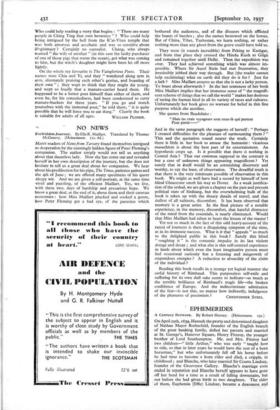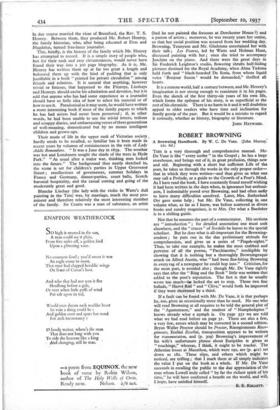EPHEMERIDES
A Century Between. By Robert Henrey. (Heinemann. iss.) ON April 29th, 1839, Hannah the pretty and determined daughter of Nathan Mayer Rothschild, founder of the English branch of the great banking family, defied her parents and married at St. George's, Hanover Square, Henry Fitzroy, the younger brother of Lord Southampton. Mr. and Mrs. Fitzroy had two children—" little Arthur," who was early "taught how to ride, so that in later years he would have the seat of a born horseman," but who unfortunately fell off his horse before he had time to become a born rider and died, a cripple, in childhood ; and Blanche, who later married Sir Courts Lindsay, founder of the Grosvenor Gallery. Blanche's marriage soon ended in separation and Blanche herself appears to have gone off her head for a time as a result of falling downstairs, but not before she had given birth to two daughters. The elder
• of them, Euphemia (Effie) Lindsay, became a deaconess and
in due course married the vicar of Brentford, the Rev. T. S. Henrey. Between them, they produced Mr. Robert Henrey, the family historian, who, after being educated at Eton and Magdalen, turned free-lance journalist.
This, briefly, is the history of the family which Mr. Henrey has attempted to record. It is a simple story of people who, but for their rank and easy circumstances, would never have found their way into a 300 page biography. As it is, Mr. Henrey has written them up at far too great a length and bolstered them up with the kind of padding that is only justifiable in a book "printed for private circulation" among friends and relations. It is natural that anything, however trivial or fatuous, that happened to the Fitzroys, Lindsays and Henreys should excite his admiration and devotion, but it is odd that anyone who has had some experience as a journalist should have so little idea of how• to select his material or of how to use it. Paradoxical as it may seem, he would have written a more interesting book if most of the family papers to which he has had access had never been preserved ; if, in other words, he had been unable to use the trivial letters, tedious and scrappy diaries, and embarrassing verses of three generations of well-meaning, domesticated but by no means intelligent children and grown-ups.
Their mode of life in the upper rank of Victorian society , hardly needs to be recalled, so familiar has it been made in recent years by volumes of reminiscences in the vein of Lady Addle Remembers. "It was a June day in 1859. The weather was hot and Londoners sought the shade of the trees in Hyde Park." "As usual after a major war, thinking men looked into the future." The background thus neatly sketched in, the scene is set for children's parties in Upper Grosvenor Street ; recollections of governesses, summer holidays in France and Germany, dinner-parties, court balls, Scotch baronial hospitality, and the casual coming and going of the moderately great and good.
Blanche Lindsay (the lady with the violin in Watts's dull painting in the Tate) was, by marriage, much the most pro- minent and therefore relatively the most interesting member of the family. Sir Coutts was a man of substance, an artist
(had he not painted the frescoes at Dorchester House ?) and a patron of artists ; moreover, he was twenty years her senior, so that her social position was assured from her wedding day. Browning, Tennyson and Mr. Gladstone entertained her with their talk ; Les Fauves, led by Watts and Holman Hunt, discussed painting with her ; once she tried to accompany Joachim on the piano. And there were the great days in Sir Frederick Leighton's studio, flowering shrubs half-hiding pictures destined for the Royal Academy, when Alma Tadema held forth and "black-bearded De Soria, from whose liquid voice Bonjour Suzon ' would be demanded," thrilled all hearts.
It is a remote world, half a century between, and Mr. Henrey's imagination is not strong enough to reanimate it in his pages. Even the sketch of the first thirty-six years of his own life, which forms the epilogue of his story, is as superficial as the rest of his chronicle. There is no harm in it and it will doubtless appeal to older readers who have time and inclination for family gossip of the past. But it would be a mistake to regard it seriously, whether as history, biography or literature.
JOHN HAYWARD.











































 Previous page
Previous page